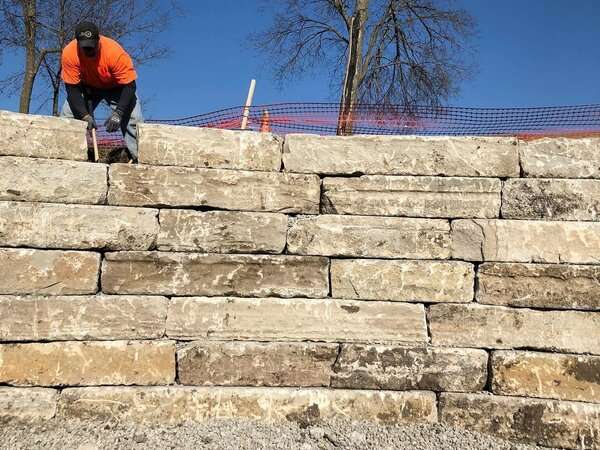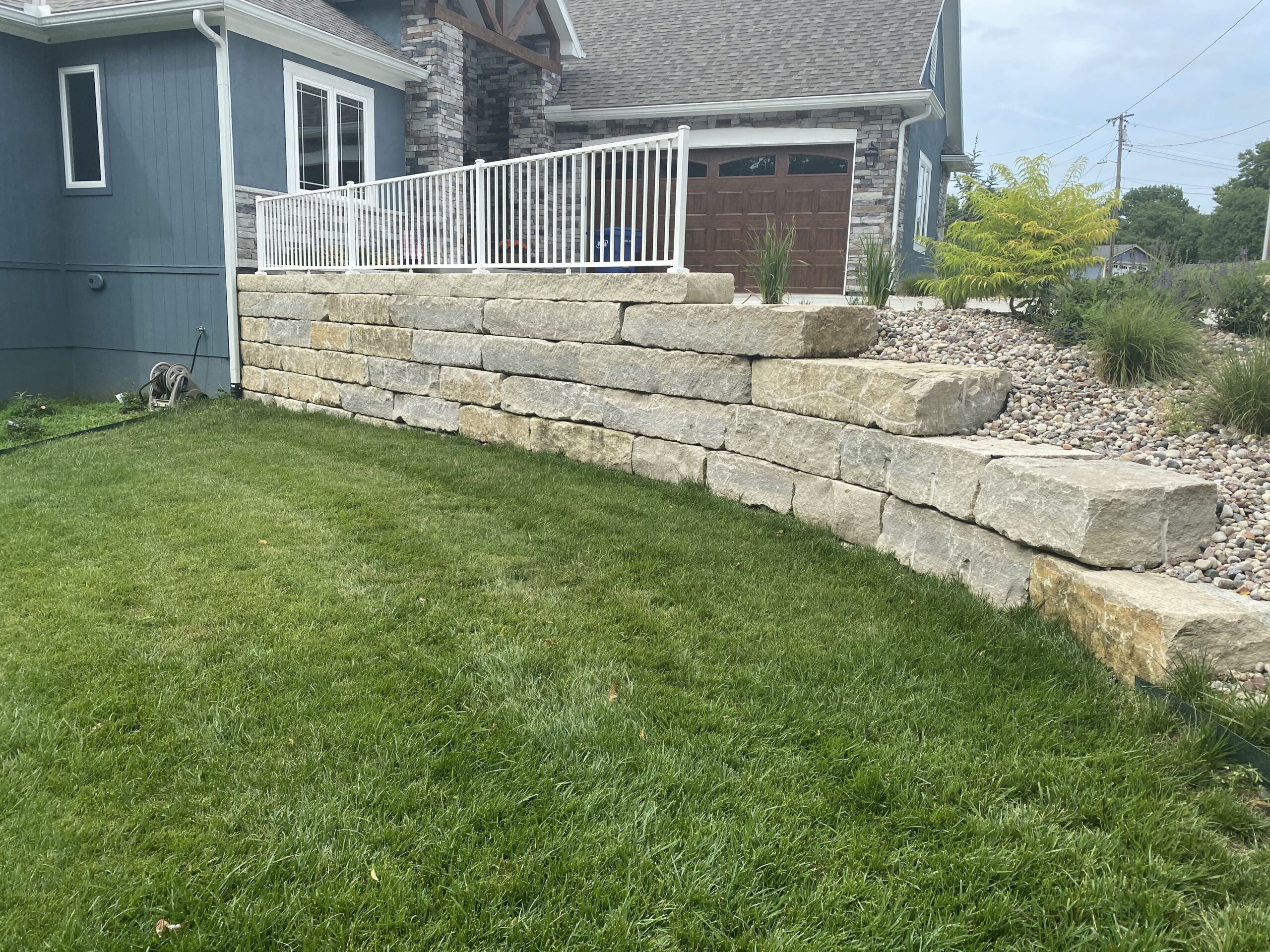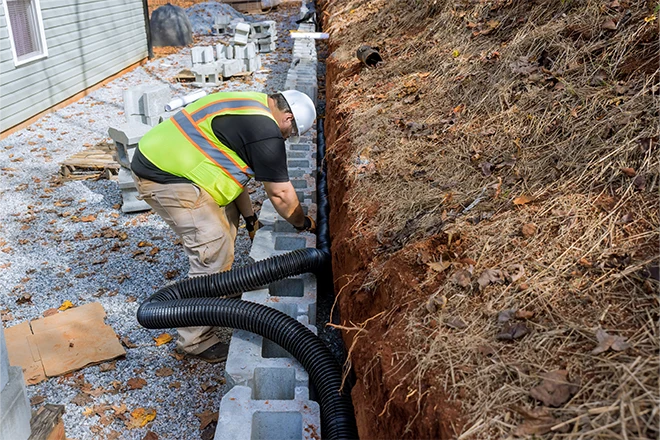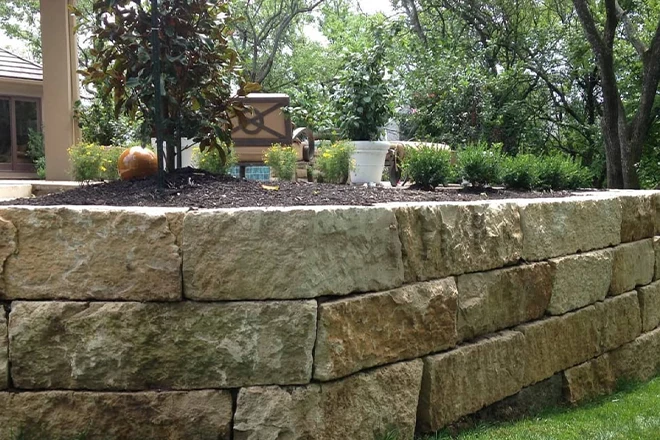Build A Safe And Strong Foundation

Have you ever looked at your sloping yard and thought, “How can I make the most of this space?” Or perhaps you’ve wondered, “Is there a way to prevent soil erosion while enhancing my property’s aesthetics?”
Build your knowledge using our guide on strong and safe retaining wall designs, tailored specifically for the unique conditions of Kansas City, Missouri.
By the end, you’ll be equipped with the knowledge to build walls that are not only strong and safe but also a testament to impeccable design (or know what to expect for your retaining wall installation in Kansas City, MO).
Key Principles For A Durable Retaining Wall Design
In the vibrant heart of Kansas City, MO, where the landscape is as varied as its culture, retaining walls have evolved from mere functional elements to integral parts of many outdoor spaces. But what ensures a retaining wall’s longevity?
Proper Drainage Systems
Adding proper drainage to your retaining wall plays a pivotal role in the longevity of your retaining wall design.
- Weep holes: Small but mighty, these openings in the wall allow trapped water to drain out. By doing so, they prevent water buildup, which can lead to soil erosion and increased pressure behind the wall.
- French drains: These are essentially gravel-filled trenches that include a perforated pipe. Positioned typically at the base of your retaining wall, they efficiently redirect water away, ensuring the wall’s foundation remains unaffected by moisture.
Reinforcements In Wall Construction
The difference between a retaining wall design that stands resiliently for decades and one that leans or even collapses often boils down to the reinforcements of the wall structure.
- Role of tiebacks and deadmen: Think of these as the backbone of your wall. They provide crucial support, especially when the soil’s lateral pressure mounts, ensuring the wall remains upright and stable.
- Importance of wall batter or lean: Introducing a slight backward tilt or lean in the wall’s design helps counterbalance the pressure exerted by the soil, adding an extra layer of stability.
Soil Compaction And Its Importance
The strength of any structure, including retaining walls, is deeply rooted in its foundation.
Achieving a compact and solid base is paramount. Techniques vary from using manual tampers for smaller areas to employing heavy machinery for larger projects.
In expansive projects, specialized tools like plate compactors are employed. These machines ensure the ground is uniformly compacted, providing a robust foundation for the wall materials.
Wall Anchoring And Support
The stability of a retaining wall design hinges on its anchoring. A wall with wall components that anchor it deeply and securely stands a better chance against external pressures.
- Deep anchoring for added stability: By ensuring the wall’s base is anchored deep into the ground, it gains resistance against potential shifts and movements.
- Cantilever retaining wall designs and counterforts: For those towering walls, these designs come into play. They help distribute the wall’s load more evenly, ensuring it remains stable even under significant pressure.
Best Practices For Retaining Wall Designs

When it comes to enhancing your outdoor space in Kansas City, MO, a well-designed retaining wall can make all the difference. But how do you ensure your wall stands strong through the test of time and the unpredictable Midwest weather?
Site Analysis And Preparation
Before you even start brainstorming retaining wall ideas, it’s essential to thoroughly understand your site.
This means conducting soil testing and analysis to determine the type of soil you’re working with. Some soils might exert more lateral earth pressure, while others could be more prone to erosion.
And before you lay the first stone or block, make sure to clear the area of any vegetation and obstacles. This ensures your wall has a solid foundation, free from potential weak points (essential for a solid retaining wall design).
Design And Blueprinting
But bringing your retaining wall idea to life isn’t just about stacking materials. It’s an intricate blend of art and science.
Your design should consider factors like wall thickness, height, and the maximum soil-bearing pressure it will face. And remember, every site has its unique challenges. Maybe you’re dealing with a yard that slopes more than usual, or perhaps you’re working close to other structures.
Whatever the case, your retaining wall design should be adaptable.
Regular Maintenance And Inspection
Even the mightiest of retaining walls need regular check-ups. Retaining wall maintenance is important for keeping your investment functional and aesthetically pleasing.
Make it a habit to inspect your wall for signs of wear or damage. Catching these issues early can save you a lot of headaches down the road.
And if you do spot a problem, there are numerous techniques available, from adding more blocks to adjusting the wall’s thickness, to ensure your wall stands tall for years to come.
Safety Considerations In Retaining Wall Design

In the bustling neighborhoods of Kansas City, MO, where every inch of outdoor space is precious, retaining walls have become a popular landscape design element. But beyond aesthetics, there’s a critical aspect often overlooked: safety.
Height And Structural Integrity
Whether it’s a short natural stone barrier or a towering poured concrete structure, each height has its considerations and requirements.
The taller your chosen retaining wall design is, the more challenges it presents. As the height increases, so does the soil pressure. It’s essential to ensure your concrete retaining wall can handle this added stress.
But with the right design, even towering retaining walls can stand strong.
Materials
The materials you choose play a pivotal role in the safety and longevity of your retaining wall. Ensuring the materials used are safe is paramount, especially important if you have kids or pets.
While natural stone walls are resistant to most threats, other materials, especially organic ones, might be susceptible to pests or decay.
Local Considerations For Retaining Wall Design In Kansas City, Missouri

Nestled in the heartland of America, Kansas City, MO, boasts a unique blend of urban charm and natural beauty. But when it comes to retaining wall design, there are specific local considerations every homeowner should be aware of:
Climate And Weather Patterns
The weather in Kansas City swings between sizzling summers and frosty winters, demanding a retaining wall that’s prepared for every season.
One significant challenge is the freeze-thaw cycle. These can be particularly harsh on walls that aren’t built with this in mind, leading to potential cracks and structural issues.
And let’s not forget the rain. With Kansas City getting its fair share of downpours, it’s vital to have a retaining wall design that incorporates proper drainage systems. This ensures the wall can handle the moisture and reduces the risk of water damage and soil erosion.
Local Building Codes And Regulations
Make sure you’re up to speed with the local rules and regulations. Every city has its standards, and staying compliant is crucial.
Safety should always be a priority. So, before you start stacking those blocks or stones, ensure your design aligns with the local safety standards.
And while you’re at it, check if you need any permits, especially if you’re building a taller or more extensive wall.
Here is how Gradex Co builds stone retaining walls for our clients.
Understanding The Basics of Retaining Walls

The importance of retaining walls is two-fold. A retaining wall creates more than just a functional addition to outdoor spaces; they’re a blend of engineering and art, especially in the diverse landscapes of Kansas City, MO.
Now that we’ve peeked into the nitty-gritty of retaining wall design, let’s go back to the basics.
Function and Purpose
Soil retention and erosion prevention: At its core, a retaining wall’s primary function is for retaining soil, especially in sloped terrain, ensuring it remains in place and preventing erosion. This not only safeguards your property but also creates level surfaces for gardens or patios.
Enhancing landscape aesthetics: Beyond their functional role, retaining walls can be a sculptural element in your yard. Whether it’s a stone retaining wall or a vertical garden, the right design can elevate the beauty of your outdoor space.
Material Choices
From natural stone to concrete blocks, the choices for your retaining wall design are vast. Each material has its pros and cons, and the best retaining wall material for you depends on your specific needs and aesthetic preferences.
The local climate, the amount of lateral pressure expected, and even your budget can influence your material choice. For instance, a gabion wall might be ideal for those looking for a blend of functionality and rustic charm.
Types Of Retaining Walls And Their Construction

When it comes to retaining wall design, one size doesn’t fit all. Depending on the challenges posed by your property and your aesthetic preferences, you might opt for one of the types of retaining walls over the other:
Dry Stacked Natural Stone Walls
- Advantages and disadvantages: While these walls exude a timeless charm and blend seamlessly with natural landscapes, they might not be the best choice for areas with significant lateral pressure or where a more polished look is desired.
- Ideal scenarios for use: Perfect for smaller walls or areas where the rustic charm of stone is a perfect fit, like a vegetable garden boundary or a decorative element in larger outdoor spaces.
Man-Made Segmental Wall Stone
- Benefits over natural stone: These walls, often made of concrete blocks, are engineered for strength. They’re designed to handle significant vertical forces and are often used in more demanding scenarios.
- Maintenance and longevity: With proper construction, these walls can last for decades with minimal maintenance. Plus, they offer more design flexibility in colors and patterns.
Timber Walls And Other Materials
- Environmental impact and sustainability: Timber, while offering a warm and natural look, might not be the most sustainable choice for your retaining wall design. It’s essential to source responsibly if opting for wood.
- Lifespan and durability concerns: Timber can be susceptible to rot and pests. However, with proper treatment and maintenance, it can serve as a durable and attractive option for retaining walls.
Find out which retaining wall type is best for your needs.
Common Reasons For Retaining Wall Failures

To ensure your wall stands the test of time, it’s essential to be aware of the common causes of retaining wall failures and how to avoid them.
Poor Foundation
Every great structure, including retaining walls, starts with a solid foundation. It’s what bears the weight and ensures the wall remains upright. B
ut what happens if the foundation isn’t deep or wide enough? Well, a shallow foundation might cause the wall to topple, especially when faced with significant lateral earth pressure.
And if the foundation is uneven? That can result in uneven pressure distribution, heightening the risk of cracks or even a complete collapse.
Inadequate Reinforcements
Think of reinforcements like the backbone of your retaining wall.
Elements like tiebacks and cantilever walls are crucial for stability. For those towering walls, tiebacks are essential as they help counteract the force exerted by the retained soil.
But it’s not just about the wall’s height. The type and volume of soil the wall is holding back also dictate the amount and kind of reinforcements needed.
Improper Drainage
Water and retaining walls have a love-hate relationship.
While a little moisture is okay, too much can spell disaster for your retaining wall design. Accumulated water behind the wall can exert a force known as passive pressure, which can lead to wall failures.
But fear not! Solutions like weep holes and drainage tiles are here to save the day.
By ensuring water doesn’t pool behind the wall, these components significantly reduce the risk of issues related to hydrostatic pressure.
Gradex Co: Your Partner In Crafting Perfect Retaining Walls
You’ve journeyed through the intricacies of retaining wall designs, understood the common pitfalls, and are now armed with knowledge. But why venture alone when you have a partner waiting in the wings?
At Gradex Co, we bring years of experience in crafting walls that are not only aesthetically pleasing but also engineered for longevity. From the initial design phase to the final brick placement, we’re with you every step of the way.
Whether you’re looking to prevent erosion, create level surfaces, or simply elevate the aesthetics of your outdoor space, Gradex Co is here to help. Fill out our contact form today, or give us a call. Let’s transform your property together!



